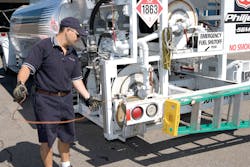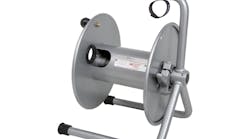How To Increase Safety And Efficiency Of Refueling Operations
On Feb. 12, 2011, 150 gallons of fuel spilled onto the apron at the Bradford County airport in Towanda, PA, flowing past the pavement and into the surrounding soil. In order to minimize the environmental damage the spill caused, the Pennsylvania Department of Environmental Protection ordered the removal of the contaminated soil, resulting in countless hours of cleanup.
Similarly, 1 million liters (264,172 gallons) of jet fuel spilled out of South Africa's OR Tambo International Airport and into the Blaauwpan Dam and storm water system on Nov. 7, 2006, damaging 5,000 cubic meters (53,819 square feet) of soil and leaving thousands of dead small animals and birds.
Although major fuel spills like these are relatively rare, thousands of smaller fuel spills occur worldwide every year. Even small spills can have devastating environmental impacts. Leaks can spread extremely quickly, and attempts to stop the flow with containment booms may be insufficient.
Ground water, soil, small animals and birds are all affected when a spill overflows into soil. Failed fueling operations are time consuming, expensive and disrupt flight traffic as well.
Deadman emergency shutoff systems prevent major fuel spills and leaks that could lead to these environmental hazards. NFPA's code 407 requires a deadman system to control fuel flow, so it is integral that all components meet these specifications.
Hannay Reels' N600 Series is a spring-loaded, dual-hose reel specifically designed for pneumatic, deadman control systems. The reel simultaneously accommodates equal lengths of two hoses ranging from ¼-inch to ½-inch in diameter. It has a compact mounting base and narrow frame for an easy fit onto any refueling truck or cart. Since the N600 Series use a self-contained spring rewind mechanism that does not require an electric connection, these reels can be installed in any position on all types of equipment.
PREVENTING SPARKS
Another important safety feature is the non-sparking ratchet that reduces risk of combustion. If the cable is rewound quickly, this feature prevents sparks that can emanate from the rotating metal. Each reel features a declutching arbor that controls cable payout and rewind, ensuring maximum cable control and less time handling the cable. This mechanism automatically locks to hold the cable in place or loosens for rewind or longer payout.
One of the most obvious safety precautions ground support personnel must take can be made even easier through static grounding reels. Using a cable reel increases safety during operations by providing a quick, convenient connection to prevent the buildup of static electricity in volatile areas. Used both in smaller airports' stationary fueling areas and on larger airports' fueling carts and trucks, reels must meet strict NFPA and ATA regulations for OEM truck and cart assembly.
These models are manufactured with specific industry requirements in mind. NFPA and ATA regulations change frequently, so engineers work diligently to ensure that the final product a customer receives not only makes the refueling process easier and shorter, but also maximizes on-site safety. Hannay Reels' HGR and GR static grounding reels are specifically designed to meet these stringent requirements and accommodate the changing needs of leading OEMs in the aviation industry.
Grounding reels make the critical refueling process as quick and easy as possible by offering smooth operation and minimal cable pull so ramp wait time is decreased. With these simple-to-use reels, operators can handle heavy fuel hoses effortlessly, instead of having to struggle pulling cable.
As with the N600 Series, Hannay also offers subcompact static grounding reels to meet specific space requirements. Sturdy, compact units can fit into almost any type of installation by offering the flexibility to be mounted at the bottom, back or sides of trucks or carts. They can also be mounted side-by-side to maximize available space on transport vehicles.
Although 95 percent of fueling operations are portable through the use of 3,000- to 17,500-gallon trucks, AV gas refuelers, regenerator ramp carts or hydrant trucks and carts, reels can also be mounted on permanent installations.
Grounding reels from Hannay are available with several connector attachments used for a variety of grounding hookups. Hannay offers different colored shielded cables in varying lengths with multiple clamps for many types of grounding fixtures, such as landing gears, posts, ground balls and rods, engine exhausts, wing lugs or bolts, bayonet plugs or metal lugs on the nose wheel strut where the tow bar attaches.
Grounding jacks, "Y" branches, and Browne and Alligator clamps are available to make the connection process easier. Single or twin leads also allow versatility during the grounding procedure.
Hannay's HGR and GR Series reels feature an adjustable guide arm that holds the cable in position. When it returns to the drum, the cable feeds neatly onto the spool rather than wrapping around the reel itself. It also keeps the cable from kinking, which can prematurely wear the cable and decrease its overall life.
The arm has teeth that adjust the reel to any position, vertically or horizontally, to dispense the cable from the top, bottom, side or back of the reel. This totally adjustable arm is designed for any cable outlet position, allowing complete user control.
Customers may choose optional stainless steel construction of the spool, frame and ratchet system to withstand harsh runway conditions. Standard, oven-cured enamel is used to coat all reels unless otherwise specified. A non-sparking ratchet assembly and declutching arbor is also featured on this model.
Designed specifically for ground support operations and built to last using the best materials available, aviation reels increase on-site safety and operational efficiency in dangerous refueling processes.
As a 31-year veteran of Hannay Reels, Ed Rash, director of marketing communications, supervises all activities and personnel involved in advertising, marketing and public relations.






